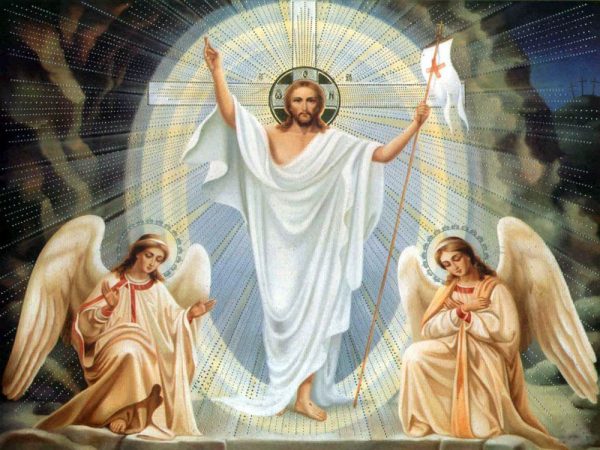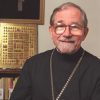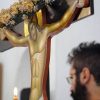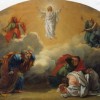Christ is risen! Truly He is risen!
The Resurrection Accounts Which Most Orthodox Never Hear
I hate to tell you this, but most Orthodox don’t know much about Jesus’ Resurrection. Well, “Christ is risen from the dead, trampling down death by death”, of course. But for years I had the nagging feeling that something was missing about our Resurrection experience in the Orthodox Church, and finally I’ve figured out what it is: most of the Pascha story!
Those who come to Sunday Matins (Orthros) hear all the Resurrection accounts on an eleven-week rotating cycle – but things being what they are, not many come to Sunday Matins. Only the minority who attend Holy Saturday morning Divine Liturgy hear Matthew’s summary of the Resurrection story. I’m afraid not enough are in church on the Sunday after Pascha to hear how Doubting Thomas became Believing Thomas. At Sunday Liturgy, Orthodox do not hear the stories of Christ’s Pascha morning appearance to the Myrrhbearing Women and then to Mary Magdalene alone in the garden, of Luke’s account of the Pascha night appearance in the upper room, of the Emmaus Road appearance, of the lovely story of the risen Lord fixing breakfast for the Apostles by the Sea of Galilee, and more. This is not enough. If there was one thing I could change in the Orthodox Church’s unchanging lectionary, this would be it.
These stories are mysterious and thrilling. What was it about the risen Lord that was so familiar, yet apparently so hard to recognize? In what way in Luke’s account was he now not “with them”, even while he was obviously there still with them? Why did he tell Mary Magdalene not to touch him because “I am not ascended to my Father and your Father”, while Matthew says the other Myrrhbearing women clung to his feet? And then there was his ability to materialize and dematerialize which (I don’t mean to be irreverent) sounds almost like modern science fiction. There is a certain feeling that hangs over these Pascha stories: luminous, numinous, transcendent, sweet, a profound calm, an immense excitement, great joy – it’s beyond words. They have a dreamy, myth-like quality, but the point is made over and over: This was no illusion. This was Real. Especially when they are read aloud (oh, I wish you would come to Sunday Matins regularly and hear them), the Resurrection stories are wonderful in the literal sense of that word, full of wonder and awe.
As we look at these stories, I’ll try to harmonize the various accounts, insofar as this is possible, and will comment on some of the little heard, little preached-on passages that are especially interesting or puzzling, And then you should take your Bibles and search them out for yourself.
Sources: Matthew 28, Mark 16, Luke 24, John 20-21, Acts 1, I Corinthians 15
But first, a short defense of the Resurrection Stories
From the beginning some have doubted or denied the Resurrection. Now, Christians have believed in the Resurrection not primarily on rational grounds, but rather beca use Jesus Christ has been alive to us. He has never been a dead hero from the past, like Buddha or Mohammed, whom we can follow if we choose. We find that he won’t leave us alone, even if we should want him to. He has been for us a living Lord. As Mark wrote, the Apostles undertook their mission, “the Lord working with them”. From the beginning Christians have worshiped Jesus and prayed to him as to God. We have “discerned him in the Body”, as Paul put it – in his Body the Church, the Holy Community; and in his Body the Holy Eucharist we have “known him in the breaking of the bread”. At Pascha midnight, who can doubt that Christ is risen and alive? That is the core reason why we believe Christ is risen.
use Jesus Christ has been alive to us. He has never been a dead hero from the past, like Buddha or Mohammed, whom we can follow if we choose. We find that he won’t leave us alone, even if we should want him to. He has been for us a living Lord. As Mark wrote, the Apostles undertook their mission, “the Lord working with them”. From the beginning Christians have worshiped Jesus and prayed to him as to God. We have “discerned him in the Body”, as Paul put it – in his Body the Church, the Holy Community; and in his Body the Holy Eucharist we have “known him in the breaking of the bread”. At Pascha midnight, who can doubt that Christ is risen and alive? That is the core reason why we believe Christ is risen.
But on the historical evidence alone, it seems very hard to disbelieve the story that 2000 years ago a Man was executed because “he claimed to be equal with God” and then rose from death. In some Sunday Matins hymns, we actually sing the Church’s reasonable answers to the skeptics! So following their example, first let’s approach the Resurrection rationally, trying briefly to answer the various questions that have been raised over the centuries.
Skeptic: Somebody stole the body. Christian: This theory was promoted immediately after the Resurrection. But why would anyone steal a naked soon-to-be-decaying body, leaving the grave clothes behind? Below is the entrance to his tomb in the Church of the Holy Sepulchre in Jerusalem.

Skeptic: The Jews stole the body so Christians could not claim Jesus had risen. Christian: Then why didn’t they produce it?
Skeptic: Jesus only appeared to die. Christian: So he was beaten up, went 60 hours without food or water, was nailed to a cross by professional executioners, hung there for six hours, and was buried. Then 36 hours later he pushed the stone away by himself, over-powered the guards, and all day Sunday ran from place to place convincing people that he was risen? Really, now…
Skeptic: The Apostles were hallucinating. Christian: Hallucinations occur to individuals, not groups. Hallucinations make people dysfunctional, but the apostles were more functional after the Resurrection. If people recover from hallucinations they see them for what they were, but the apostles always believed in the Resurrection.
Skeptic: The Apostles made it up. They stole his body and pretended he had risen. Christian: To what purpose? All they got out of it was exile and trouble. All except John were martyred for it. Obviously they were not charlatans.
Skeptic: The Resurrection accounts are not consistent in details. Were there one or two young men at the tomb? or were they angels? who saw him first? and so on. Christian: This is exactly what we would expect if the accounts were true. Even under ordinary circumstances different people see and remember the same events slightly differently – let alone if something unexpected and startling happens. If police investigate an accident and all the bystanders agree about every detail, they immediately suspect somebody is up to something. The Gospels are not like that. The writers obviously did not plot to coordinate the accounts. However, they agree on the fundamentals: The tomb was empty, Christ rose bodily, his bodily appearances continued for a time, then ceased.
Skeptic: Modern science has proved that miracles don’t happen. Christian: This is not true. (The Christian who is writing this Blog has a degree in meteorological science.) Science deals with things which happen regularly and will hold still to be measured and analyzed. Miracles do not, so science can’t speak to the subject of the Resurrection, one way or the other.
Skeptic: Modern Biblical criticism has proved the the Resurrection story is no more than a myth. Christian: This is not true. Actually this was 19th and 20th century textual criticism which often was just wild speculation. In the first place, myths took place no one knew when or (usually) where. The Gospels were written as history. (See Luke 3, for example.) When in 1961 my Methodist New Testament professor, just before Holy Week, “proved” that Palm Sunday never happened, I became skeptical of the skeptics. I decided that if Matthew, Mark, Luke and John didn’t get the story straight, the chances were slim that Professor Lundgren, nineteen centuries later in an entirely different culture, had figured it out. We Orthodox are neither fundamentalists nor literalists, and of course we’re allowed to speculate on why the Bible was written as it was, but in what follows I’ll take the texts at face value.
Now, let’s begin, taking the stories from the beginning.
Holy Friday

Jesus was dead. It was women’s work to anoint the bodies of the dead and wrap them in a shroud. Joseph of Arimathaea had gone to Pilate to ask for the body and had provided his new family tomb, a cave, for his burial. (The rocky landscape in the area did not allow burial in the ground.) But the anointing had not been completed. Christ had died at 3 p.m., and at sunset the Sabbath began when Jewish Law did not permit anointing of the dead. So they buried him quickly. A large stone was set over the door. Matthew says it was remembered that he had spoken of rising from the dead, so the Jews had Pilate set a guard of soldiers so the disciples could not steal the body and claim he was risen – though the accounts suggest the disciples were too afraid and distraught even to think of such a thing.
Pascha Morning
As soon as they could, on Sunday just before dawn, the Myrrhbearing Women went to try to complete the prescribed anointing, wondering how ever they were going to get into the tomb. Matthew says that as they arrived there was an earthquake, a radiant angel rolled the stone away and the soldiers passed out. Luke says only that the stone had been removed, and that two men in shining garments stood there. Mark mentions only “a young man in a white robe”. “Do not be afraid”, he (or they) said. “He is not here. He is risen. Come, see the place where he lay. Go tell his disciples.”
The sequence of what happened next is not quite clear – and little wonder, for the women and then the Apostles were startled, awestruck, frightened, and nobody was taking notes. The women ran back to the city to tell the Apostles. Matthew says Jesus met them on the way saying “Rejoice”, that they “worshiped” him, clinging to his feet, and he said, “Go tell my brethren that I will see them in Galilee”. The women did so, but the disciples refused to believe them, not surprisingly. This was hard to believe. Luke says Peter then went to the tomb.

John gives a slightly different version: Mary Magdalene went to the tomb and found the stone already moved away. She ran to Peter to tell him. (If we wish to try to harmonize this with Matthew’s account, can we imagine that she did this apart from the other women, and so did not meet Jesus with them on the way back?) Peter and John went to the tomb to see. John says he got there first, but (out of fear? respect for the chief Apostle?) let Peter go in first. They found it as Mary had said. John mentions the linen shroud lying there and the head cloth neatly folded. (Did the Apostles keep these cloths? Was one what is now called the Shroud of Turin? Another cloth now in Sovieto, Spain is claimed to be the head cloth.)
Did Mary Magdalene go back to the tomb with Peter and John? For John says she remained in the garden weeping. Through her tears she saw a man whom she assumed to be the gardener, who asked her “Why are you weeping?” She explained and asked, “Tell me where they have taken him”. The Man said to her, “Mary”. She said, “Rabboni, (dear teacher)!” He replied, “Do not touch me; I have not yet ascended” to the Father. “But go to my disciples”, he said to Mary. Mary Magdalene went and told them “I have seen the Lord.” When this story is read aloud at Matins early on Sunday morning, I always get the holy chills.

















